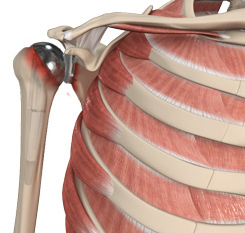
Total shoulder replacement addresses the deterioration of the shoulder joint by substituting the damaged head of the humerus and the glenoid cavity with artificial prostheses. This procedure aims to alleviate pain, swelling, and stiffness resulting from cartilage damage at the joint’s articulating surfaces. Although total shoulder replacement typically yields positive outcomes, there are instances where revision surgery becomes necessary due to persistent pain, infection, stiffness, weakness, instability, hardware loosening, malposition, or fracture.
Complications associated with total shoulder replacement may arise from factors such as osteophyte formation (bone spurs), scar tissue formation, deficits in supporting muscles, nerve injury during surgery, soft tissue imbalance, and presence of loose bodies. Additionally, complications may occur if the components are too large, become loose, or are improperly positioned. Failure to engage adequately in the rehabilitation program and exerting excessive strain on repaired tendons prematurely can also contribute to surgical failure.
Before opting for revision surgery, your physician will conduct a comprehensive review of your medical history and perform a thorough physical examination to pinpoint the cause of failure and determine the most suitable treatment approach.
Revision surgery is typically performed under general anesthesia, with patient positioning optimized to accommodate various treatment modalities. Incisions are strategically made to provide optimal access to the problem area, often following previous incision sites with extensions as needed. Revision entails the removal of obstructing structures such as scar tissue. Stiff muscles, tendons, and ligaments are released to enhance range of motion, while injured ones may be repaired using tendon grafts. Ill-fitting components are either replaced or adjusted, and fractures may be stabilized using plates, screws, and wires. In cases of infection, soft tissue debridement (removal of infected tissue) and irrigation with antibiotic solution are usually performed. Chronic infections may necessitate component replacement. Special care is taken to safeguard muscular and neurovascular structures, whose positions may have been altered by prior surgeries.
Revision shoulder replacement surgery is a procedure performed to replace a failed or worn-out shoulder implant with a new one. This type of surgery is necessary when a primary shoulder replacement, also known as total shoulder arthroplasty (TSA), fails due to various reasons such as loosening, instability, infection, or excessive wear and tear over time.
Outcomes:
Revision shoulder replacement surgery can help alleviate pain, restore function, and improve quality of life for patients whose primary shoulder implants have failed. However, the success of the procedure depends on various factors, including the underlying condition, surgical technique, and patient compliance with rehabilitation.
Indications for Revision Shoulder Replacement:
- Loosening: Over time, the components of a shoulder implant may become loose, causing pain and instability.
- Instability: Instability occurs when the shoulder joint dislocates or subluxates, leading to recurrent pain and limited function.
- Infection: Infection can occur in the shoulder joint, leading to pain, swelling, and possible implant failure.
- Wear and Tear: Excessive wear and tear on the implant components can result in decreased function and increased pain.
- Fracture: Fractures around the shoulder implant may require revision surgery to restore function and stability.
- Component Failure: Failure of any component of the shoulder implant, such as the glenoid component or humeral component, may necessitate revision surgery.